Crankbait Fishing Plugs
How To Catch Big Bass With Crankbait Fishing Plugs
Crankbait fishing plugs can catch big bass if fished with the right combination of size, color, speed, depth and sound and when bass are active and feeding, which are the best times for plug fishing when targeting big bass.
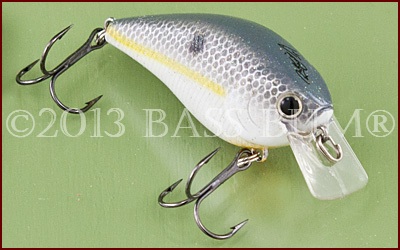
Crankbait fishing plugs are bass catchers and at certain times are considered the best big bass lure. Their versatility makes them that way. No question. However, they're at their best when the angler is more interested in numbers rather than when he/she is targeting that one big ass fish.
"Not Tonight Honey, I'm Just Not In The Mood"
Big bass are not usually inclined to chase very far after crankbait lures that flash by though they are, by their anatomical structure, well suited for making short dashes to suck in prey. Especially true if they are in an inactive feeding mode. In fact, really huge bass don't ever expend a lot of energy chasing forage.
A very key consideration in catching big bass plug fishing is the activity level of the bass. Mature bass, those of great size, tend to be loners that hold up a majority of the time around some favorite, usually isolated, structure in an inactive state. They do this to rest and hide from predators. They are sometimes holding so close to cover you couldn't even find them with your electronics. When they're in an inactive mood, holding close to structure and/or cover, you could literally hit them in the head with any lure, including a crankbait, and still not be guaranteed it would solicit a strike.
However, they must still eat to survive so when the urge arrives they venture out in search of dinner. When feeding, big bass are most always moving. Contrary to popular belief they don't lay in wait, like a lion in tall grass poised to spring on an inattentive gazelle. However, they will sometimes take a meal even when deep in cover, if they're not in an inactive mood. That is if the meal comes close and appears easy to catch with little effort. That won't be a crankbait. A worm or jig is more in order.
Normally, real big bass will cruise the edges of various types of cover and structure searching for prey in any cuts and openings. By doing this or aggressively swimming the open water around cover they can frighten and flush baitfish from cover. It is during these periods of active feeding that the angler's odds of catching a lunker increases. This is when fishing plugs the right size, shape and color, retrieved at the right speed and depth, have the potential of scoring big.
This feeding tactic is a good thing for we who enjoy plug fishing. For obvious reasons there is always a reluctance to toss a favorite fishing plug into heavy cover, be it grass or brush. But that isn't where really big bass will be when actively feeding. They will be outside the edges, right where we want them.
So You're Thinking, "Just How Will I Know When The Big Bass Are Putting On The Feed Bag?"
You've come to the right place my friend. First off, understand that bass in general, but especially big bass, feed for only short periods of time. Additionally, the short periods when big bass feed, which occur within a general six hour period in spring and fall, are few and far between compared to smaller bass that feed more often. Broadly speaking, the best times to find big bass include pre-spawn, pre-frontal conditions, early mornings, late afternoons and summer nights. Of course, these periods vary depending on whether it's spring, summer, fall or winter and on weather conditions with the biggest influence any time being water temperature.
"What About The Moon? That Makes Big Bass Feed, Right?"

I'm not a committed believer in the relationship between freshwater bass, big or little, and lunar influences, though there is enough anecdotal and research information to support the "possibility" that it does indeed affect, to some extent, the activity levels of fish that live in the seas and are subject to tidal changes, but freshwater bass; not so much.
Nevertheless, some observations about lunar affect on big bass are that the three, some say four, days just before and just after a full and new moon are high activity periods for big bass. However, this does not mean they will be active during the daylight hours of these six or eight days surrounding a full moon. Why not? Big bass routinely feed most heavily during dusk. Light levels present during the period of a full moon are very close to that available at dusk. As a result, big bass tend to "pork up" in the light of the moon and may become sluggish during the following daylight hours. Sort of like we feel after going to a Sunday brunch. Couch time! Another example of why chasing crankbait lures depends on the activity level of the bass?
Still, other long time bass fishermen swear the best time for catching big bass is two hours before and after when the half moon rises and sets in the middle of the day and night. This influence is, in their opinion, strongest in the spring and causes high levels of aggression in bigger bass.
OK, They're Hungry, Now What?
Look for them in 8' to 12' deep water, the depth range long time anglers, in addition to numerous studies, have identified as the depth where lunker bass focus their feeding activities. I don't mean they suspend in these depths. This is the range through which they migrate from their safety zone cover to feeding grounds. This then, is where an angler should focus; casting crankbait fishing plugs parallel to the edges of points, steep banks, grass beds, creek channels or steep drop-offs. It's an added benefit if these structure features also face into current or winds which serves to attract baitfish. Casting bass crankbaits at a ninety degree angle to any structure where you suspect big bass to be will minimize the amount of time your crankbait is in the strike zone.
Before going to water in your pursuit of big bass you'll serve yourself well if you get a good lake contour map. Look for "funnel areas" where 8'-12' deep water merges into shallow.

The Importance of Stealth When Chasing Big Bass
Big bass managed to become big by honing their survival skills. They have an intimate knowledge of their habitat and have over time become adept at using cover for protection and avoiding danger. They are extremely wary and any unusual loud noise, loud being what is not normally a part of their otherwise quiet world, or an intrusion into their domain sounds an alarm, alerting them to the possibility of danger. Any clanging around in your boat, dropping things or slamming locker compartment lids will work against your efforts to land a real big fish.
This need for stealth extends to crankbait fishing. If you're constantly moving you're going to spook the larger bass that lay ahead of the boat. Remember, feeding bass tend to feed in loose groups, even the big ones, and are constantly moving back and forth along cover and structure when doing so. If you're moving along at a fairly good clip, you will likely spook those ahead of your boat with your trolling motor, which will scatter and take off for deeper water, especially the big hawgs.
A better approach? Locate an edge that is 8'-12' deep where deep and shallow water meet and along which feeding bass will be hunting. If that edge, hump or point holds scattered cover like grass or stumps there is a good chance big bass will be feeding there. Set up along this shallow/deep water transition and maintain your position, or while moving very slowly parallel to the changing shape of the edge, and make multiple accurate casts parallel to the edge be it vegetation, a bluff wall or a drop-off. This keeps crankbait fishing plugs in the feeding zone longer and effectively covers more territory along the edge.
If you're casting straight toward or even at a 45 degree angle to the edge of the cover or structure you're going to miss a lot of the feeding zone. Making multiple, accurate casts retrieved at the right depth so your fishing plugs stay in the feeding zone bumping bottom or deflecting off cover is the key.

Bass Bum Best Bet™ Crankbait Fishing Plugs for Big Bass
There are numerous crankbait fishing plugs that can be effective catching big bass. The following have proven themselves to me. Try them but find your own favorites.
Grass
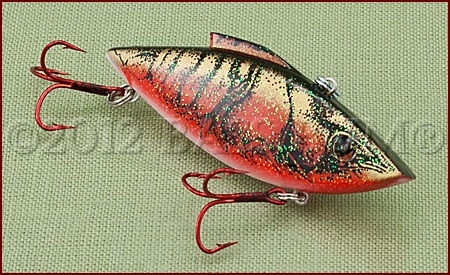 |
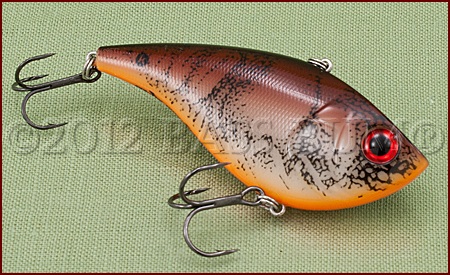 |
|
If the water is over 55° grab a Rat-L-Trap. This classic fishing plug has never lost its ability to call up big bass around grass. Retrieve it with a steady, rapid pace along the outside or inside edges of the bed. Or retrieve across the bed's top making sure it ticks the tips of the grass popping it free should it bog down. If the grass is 1' to 2' below the surface use a 1/4 ounce version. If the depth to the top of the grass is 3' to 4' a 1/2 ounce size is better. Deeper than this, move up to a 3/4 ounce "trap". |
A good crankbait fishing plug for fishing over grass because its design enables the angler to kill it over gaps in the weed bed and drop it on semi-slack line into a gap with a level descent. Once on the bottom snatch it up and out. You can also yo-yo it along the outside edge of a grass bed, especially if the edge is deep, say 15', or it's located along a drop-off to deeper water. |
Flats and Shallow Water
Flats become extremely attractive in the fall when the baitfish begin leaving deeper water and begin their migration to the back of creeks or coves off the main channel. There are often flats along the way and any isolated cover on a flat is not to be passed by. This isolated cover will often be where the hawgs are lurking. When the water drops into the 60's it's time to leave behind the big worms and slower presentations used on summer flats. Go horizontal and start chunking crankbait fishing plugs. Remember, bump the stump, log, rock pile whatever cover found on the flat.
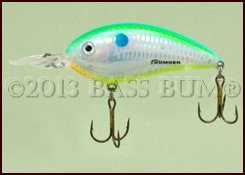 |
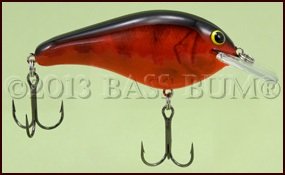 |
|
This little beauty is a great choice for banging the rocks, bumps and stumps on flats in water 4'-6' deep. Remember, deflection is a key part of effectively presenting a crankbait. |
A really slick lure. Thin body with flat sides. This one has a short, coffin style bill which takes it down 4'-8' and deflects well off cover. |
Points, Bluffs and Rock Banks
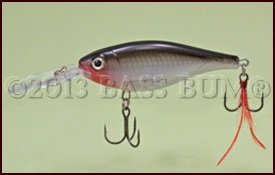 |
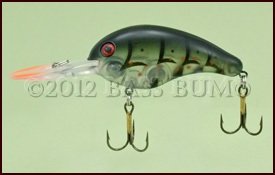 |
|
It's important that crankbaits deflect. No doubt an abrupt change in the direction of a fishing plug often draws strikes. Though this lure looks to be a jerk bait, its also a crankbait that suspends. As such, I've found it to be a good double duty lure. Great for big largemouth but also a good suspending "crankbait" for smallmouth suspending off bluff walls and points. |
If you're targeting big bass in spring moving from deep to more shallow water by way of primary or secondary points or along chunk rock breaklines, this lure will get down to them without a lot of fuss, as it's silent. You gotta know that big bass are tuned in to the human connection the million rattling lures thrown at them every year have. A quiet, deep running lure is less likely to fire up their well developed sense of danger. |
Back To Big Bass Fishing From Fishing Plugs For Big Bass
